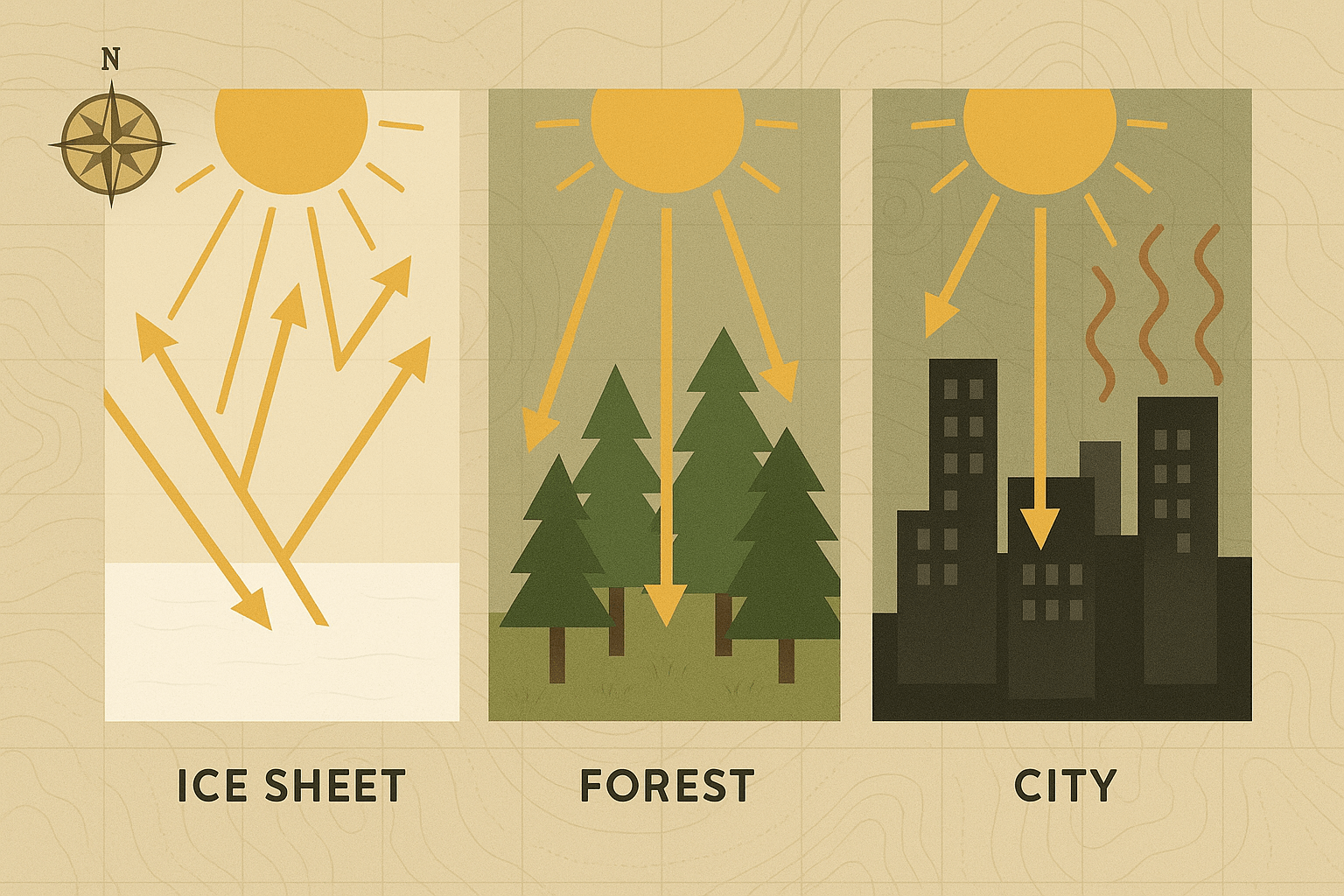Ever walked barefoot on a hot summer day? You’ve probably noticed the searing heat of dark asphalt compared to the relative cool of a white-painted crosswalk. This everyday experience is a perfect microcosm of a powerful planetary force: the Albedo Effect. Far from being a niche scientific term, albedo—the measure of a surface’s ability to reflect sunlight—is a critical driver of our world’s climate, woven deeply into its physical and human geography.
Simply put, albedo is Earth’s shininess. It’s measured on a scale from 0 to 1. A surface with an albedo of 0 is a perfect absorber, soaking up all incoming solar energy (think of a theoretical black hole). A surface with an albedo of 1 is a perfect reflector, bouncing all that energy back into space. Every landscape on our planet, from vast oceans to sprawling cities, has its own albedo value, creating a complex patchwork quilt that determines where heat is absorbed and where it’s reflected.
The Great Reflectors: Polar Ice and Snow
The champions of reflectivity are Earth’s polar regions. Fresh, brilliant white snow has an albedo of up to 0.9, meaning it reflects as much as 90% of the sunlight that hits it. Sea ice, being slightly less pristine, still boasts a high albedo of around 0.5 to 0.7. Geographically, this makes the Arctic and Antarctic Earth’s giant refrigerators.
These vast expanses of white act as enormous mirrors, reflecting solar radiation back into space and exerting a powerful cooling influence on the entire globe. However, this high-albedo shield is dangerously sensitive to temperature, creating one of the most critical feedback loops in our climate system.
The Ice-Albedo Feedback Loop
This concept is a cornerstone of modern climate science. Here’s how it works:
- Warming Occurs: Global temperatures rise, causing snow and ice to melt.
- Dark Surfaces Exposed: As the ice melts, it exposes the much darker land or ocean surface beneath. The deep blue ocean has a very low albedo (around 0.06), as does tundra rock.
- More Heat is Absorbed: These darker surfaces absorb significantly more solar energy instead of reflecting it.
- Warming is Amplified: This absorption of heat further warms the region, causing even more ice to melt.
This vicious cycle is a positive feedback loop, meaning it accelerates the initial change. We are seeing this play out in real-time in the Arctic, which is warming at more than twice the rate of the global average. The shrinking of the Arctic sea ice is not just a tragedy for polar bears; it fundamentally reduces Earth’s overall albedo, contributing to further global warming.
A Complex Tapestry: Forests, Deserts, and Oceans
Moving away from the poles, the geography of albedo becomes more nuanced.
Forests: You might think that a green forest is more reflective than dark soil, but dense forests, particularly the evergreen boreal forests of Canada and Siberia, have a surprisingly low albedo (0.05 to 0.15). Their dark, complex canopy traps and absorbs a great deal of sunlight. However, forests also have a powerful local cooling effect through evapotranspiration—releasing water vapor that cools the surrounding air, much like sweating cools our skin. So, their climatic role is complex.
Deserts: The world’s great sandy deserts, like the Sahara in Africa, have a relatively high albedo of around 0.4. They reflect a substantial amount of solar energy, influencing regional weather patterns. This is in stark contrast to the world’s oceans.
Oceans: Covering over 70% of our planet, the dark surface of the ocean is the single largest heat absorber. With its very low albedo of ~0.06, it acts as a massive solar battery, soaking up the sun’s energy. This stored heat drives ocean currents, fuels hurricanes, and dictates weather systems for coastal and even inland countries thousands of miles away.
The Human Touch: Cities and Agriculture’s Albedo Footprint
Human geography leaves a distinct and often dark mark on the planet’s surface, with significant albedo consequences.
The Urban Heat Island Effect
Cities are textbook examples of low-albedo environments. Consider the materials that define a modern metropolis:
- Asphalt roads: Albedo of 0.05 – 0.1
- Dark roofing materials: Albedo of 0.1 – 0.2
- Concrete and brick: Albedo of 0.2 – 0.4
This vast collection of dark, heat-absorbing surfaces creates the “Urban Heat Island” effect, where cities like Tokyo, Phoenix, or Mumbai can be several degrees warmer than their surrounding green, rural landscapes. This extra heat increases energy demand for air conditioning, exacerbates air pollution, and poses health risks during heatwaves.
In response, a new geography of urban planning is emerging. Cities from Los Angeles to Melbourne are implementing “cool roof” and “cool pavement” initiatives. This involves using more reflective materials, including special white or light-colored coatings, to increase the city’s albedo. By reflecting more sunlight, these simple geographic interventions can lower ambient temperatures, reduce energy bills, and create more livable urban environments.
Agriculture’s Impact
Agriculture also transforms the landscape’s albedo. The act of clearing a dark forest (low albedo) to plant crops (often higher albedo, especially when mature) can lead to a slight local cooling effect by reflecting more sunlight. However, this is often a geographic red herring, as the immense carbon emissions from deforestation far outweigh any minor cooling benefits from the albedo change.
A World in Flux
The albedo effect is not a static property of our planet; it is a dynamic and vital sign of its health. The melting of the Himalayan glaciers—the “Third Pole”—is another alarming example of the ice-albedo feedback loop, threatening the water supply for billions in Asia. The color of our planet matters.
From the fate of the polar ice caps to the temperature on a city street, the geography of reflectivity shapes our daily lives and our collective future. It demonstrates that the physical characteristics of our planet and the ways we choose to live upon it are inextricably linked. Understanding this simple principle of light and dark is more critical than ever as we navigate the challenges of a warming world.
